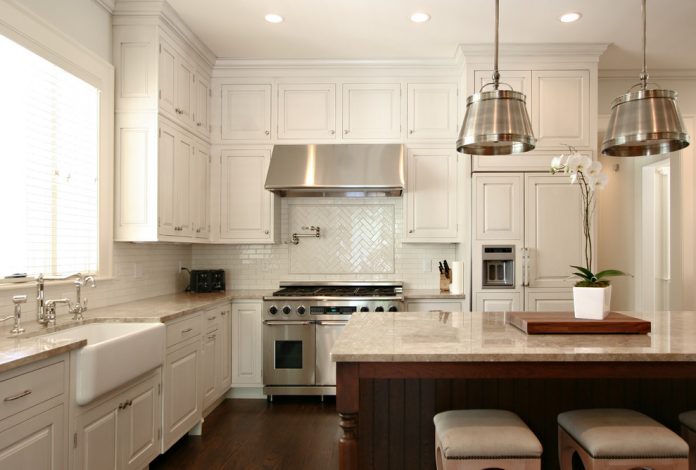Not all kitchens are created equally. If you have ever cooked, baked, or prepared a meal in a really well-designed kitchen (or a horribly designed kitchen) then you probably took notice of how much the layout of your kitchen can affect the efficiency of the work you do. For decades the “Kitchen Work Triangle” was the go-to way to design the layout of your kitchen.

The concept of the kitchen work triangle is the thought that in a properly designed kitchen you should be able to draw an imaginary line between the center of the refrigerator, the center of the sink, and the center of the range or cooktop. This idea was developed in the forties to increase the efficiency of work in the kitchen. There is a lot of thought behind the kitchen work triangle. Much of the cooking and cleaning that goes on in the kitchen will involve walking between the three major appliances so by adhering to the work triangle you should, in theory, be able to get more work done in less time or with less effort.
There are a number of other rules that go along with designing a kitchen work triangle. Some are more of suggestions rather than rules.
- If you add up the total sum of the work triangle’s sides they should be 26 feet or less.
- Each leg of the work triangle should measure somewhere between 4 and 9 feet.
- Any obstructions to the sides of the work triangle, like tables or islands, should be minimal. (12 inches at most)
- No major foot traffic should pass through the triangle.
- A sink should have clear counter space consisting of at least 24 inches on at least one side.
- A refrigerator should have clear counter space consisting of at least 15 inches on the handle side.
- A stove or cooktop should have clear counter space consisting of 12 to 15 inches on either side.
The kitchen work triangle can improve the workflow of most kitchens regardless of the layout. Naturally, the kitchen work triangle works best in the U-shaped kitchen. The three distinct runs provide numerous options for where to place your appliances and still work within the rules of the work triangle.

The L-shaped kitchen also provides good placement options for your appliances. It is easy to make the triangle work in this layout but keep the third rule about obstructions in mind because L-shaped kitchens so often feature larger islands.
 The galley kitchen is usually a little more constrained than the other two popular layouts but it too can utilize the kitchen work triangle and maximize efficiency.
The galley kitchen is usually a little more constrained than the other two popular layouts but it too can utilize the kitchen work triangle and maximize efficiency.
 Unfortunately the kitchen work triangle is not always possible. In small apartments, the lesser rules that dictate the desired counter space that should accompany each major appliance is optimistic at best. Even if you lack the space needed to have a truly efficient work triangle, you can still have a fairly usable kitchen by sticking to as many of the rules as possible.
Unfortunately the kitchen work triangle is not always possible. In small apartments, the lesser rules that dictate the desired counter space that should accompany each major appliance is optimistic at best. Even if you lack the space needed to have a truly efficient work triangle, you can still have a fairly usable kitchen by sticking to as many of the rules as possible.
In many of today’s more modern kitchen designs, there has been a slight departure from the kitchen work triangle. New homes are being designed with one great room that combines the living room, dining room, and kitchen into one open space. These open designs often focus more on the kitchen as a social area for entertaining. Large areas of the kitchen are reserved for bar-like dining areas on the back sides of peninsulas or large islands.
 Most of these kitchens still incorporate many of the rules of the kitchen work triangle but there is a clear focus on making the kitchen a multi-functional space. If your kitchen is particularly large, the kitchen work triangle may not be the best way to design your kitchen. Most larger kitchens, especially ones designed to have more than one person cooking at once, will go with a work zone design in favor of a kitchen work triangle.
Most of these kitchens still incorporate many of the rules of the kitchen work triangle but there is a clear focus on making the kitchen a multi-functional space. If your kitchen is particularly large, the kitchen work triangle may not be the best way to design your kitchen. Most larger kitchens, especially ones designed to have more than one person cooking at once, will go with a work zone design in favor of a kitchen work triangle.
I never put much stock in the idea of the work triangle until I moved out of my parents’ house. As someone who likes to cook and bake, I was fortunate to grow up in a house with a nice U-shaped kitchen that adhered to the kitchen work triangle. The left run had a large spacious cooktop, the right run was a massive pantry area with the refrigerator, and finally, the sink was centered on the middle run of the kitchen. My mother often wished for a kitchen island but I doubt there would have been adequate space for it. A stark contrast to that kitchen, the house I currently live in has a kitchen that, from a design standpoint, is barely functional.
 My current kitchen has a small galley layout with a sink centered on one run while the range and refrigerator both sit side-by-side on the end of the other run. At best, the longest side of the “triangle” that is formed by this design is about 4 feet. This workspace is entirely too small but to make matters worst, the tiny triangle is also a major intersection of a hallway, kitchen, living room, and the only working bathroom in the house.
My current kitchen has a small galley layout with a sink centered on one run while the range and refrigerator both sit side-by-side on the end of the other run. At best, the longest side of the “triangle” that is formed by this design is about 4 feet. This workspace is entirely too small but to make matters worst, the tiny triangle is also a major intersection of a hallway, kitchen, living room, and the only working bathroom in the house.
If you are planning on remodeling your kitchen you should think about all the rules of the kitchen work triangle. Even if your particular needs do not require a traditional work triangle design, keeping these rules in mind will help you design a layout that will be efficient enough for you to enjoy the time you spend in your kitchen.












